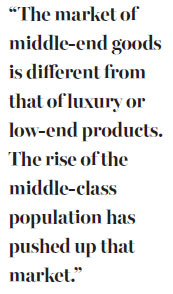Middle-class consumers key to economic growth
Updated: 2016-09-23 07:59
By He Jun(China Daily Europe)
|
|||||||||
People who look down on consumer spending do not understand what will happen in the future
Consumption has played a greater role in China's economy as growth has slowed, replacing the reliance on investment to power development. Last year, consumer spending accounted for 66.4 percent of GDP growth, a 15-year peak. And in the first half of 2016, the contribution exceeded 70 percent, a historic level.
In global terms, consumer spending accounts for 62 percent of a developing country's GDP growth, on average. It can be more than 90 percent in some, however.
China is in a process of transition from exports-driven economic growth to a mode led by domestic consumers. Some people have doubted the importance of the transition, arguing that the rise in spending was a consequence of a decrease in investment over the past two years. This is a shortsighted view, and people who look down on consumer spending do not understand what will happen in the future.
The question is: What can China do during this transition?

Some market insiders are too pessimistic, saying that the market is lacking light spots as the sagging economy reduces consumer expectations for income growth. People ask: How can we take consumption as the main power for growth when sales of luxury cars, watches, handbags and even domestically made beer and instant noodles are falling?
The answer is simple. China's market may not perform well in terms of high-end or low-end retail, but the consumption of mid-level products is booming.
Ai Tian, vice-president of Carlyle Group, told the Financial Times recently that the golden time for Chinese consumers of luxury products may end because of the slowdown in domestic growth, the government's anti-corruption moves, and the fact some luxury products have become too popular.
Spending on luxury goods began to fall in China in 2014 and has continued to drop, Ai says. Last year, the number of Swiss watches purchased in Hong Kong - the barometer for luxury watch sales in China - fell 23 percent compared with the same period in 2014. Also last year, sales of Rolls-Royce cars in the Chinese mainland fell 54 percent year-on-year.
What's more, Chinese consumers have begun to believe that some high-end consumer goods have become mass-market products, which are no longer worth pursuing.
The prospects for the low-end commodity market are gray, too. Price competition, which is favored by cheap, low-quality brands, doesn't work. Chinese consumers, who have spending power and want to spend, are paying more attention to quality. Cheap, low-end or unhealthy products just don't satisfy any more.
Taking fast-moving consumer goods as an example, last year, Chinese people's spending on instant noodles fell 12.5 percent, while spending on beer fell 3.6 percent. This data is echoed in research by Bain & Co, which shows purchases of fast-moving consumer goods in Chinese cities dropped 0.9 percent last year. In terms of value, growth was down 3.5 percent year-on-year, a five-year low.

In contrast, the total value of social consumer goods sales in the first half of 2016 rose 10.3 percent. The gap indicates that the structure of the Chinese consumer marker is changing. We expect the performance of soft drinks companies, including Coca-Cola, will decline in China.
The market of middle-end goods is different from that of luxury or low-end products. The rise of the middle-class population has pushed up that market.
The popularity of high-quality, low-price South Korean cosmetics is a good example. Brands such as Innisfree, Laneige and Etude appeal to Chinese young ladies. Annual sales of other middle-end brands such as Japan's Uniqlo saw a 62 percent increase year-on-year. Also, Decathlon, the French sports goods chain, has increased its number of stores in China to 166 from 55 three years ago.
Chinese brands focusing on middle-class consumers also saw quick development. Restaurants such as Green Tea and Grandma's Home, both based in Hangzhou, the capital of Zhejiang province, doubled the number of their branches nationwide within two years.
As President Xi Jinping once said, the Chinese market never lacks consumer demand. But the immutable supplies and services at home have failed to satisfy consumer demand, which continues to change. Chinese people have begun to turn to overseas markets to buy high-quality daily necessaries such as electric cookers, toilet lids, formula milk and nursing bottles.
As the middle-class population increases, the transition to a consumer economy cannot stop. Consumption will finally become the major power that pushes growth, and the middle-class demand is the key to increase sales.
The author is a senior researcher with Anbound Consulting. The views do not necessarily reflect those of China Daily.
( China Daily European Weekly 09/23/2016 page11)
Today's Top News
State of emergency declared in US city amid protests
Universities given boost in rankings
Demand for Mandarin rises in UK
China 'capable of keeping medium-to-high growth'
Li tells Obama of opposition to THAAD deployment
Greek vows to improve refugee situation on island
UN suspends aid convoys following deadly strikes
New York bombing suspect captured in New Jersey
Hot Topics
Lunar probe , China growth forecasts, Emission rules get tougher, China seen through 'colored lens', International board,
Editor's Picks

|

|

|

|

|

|







